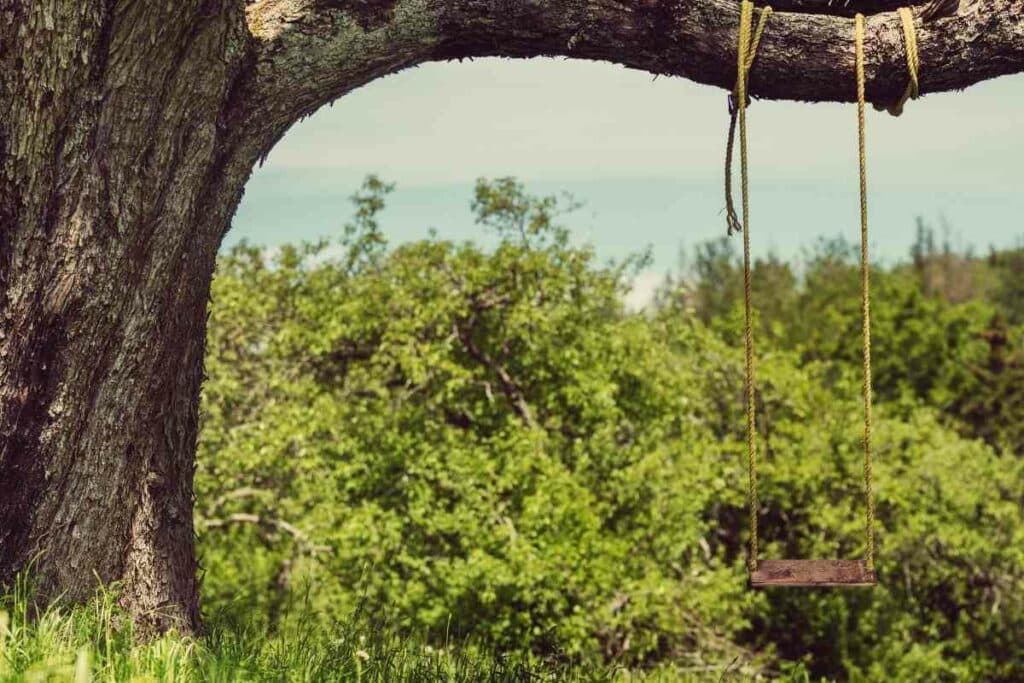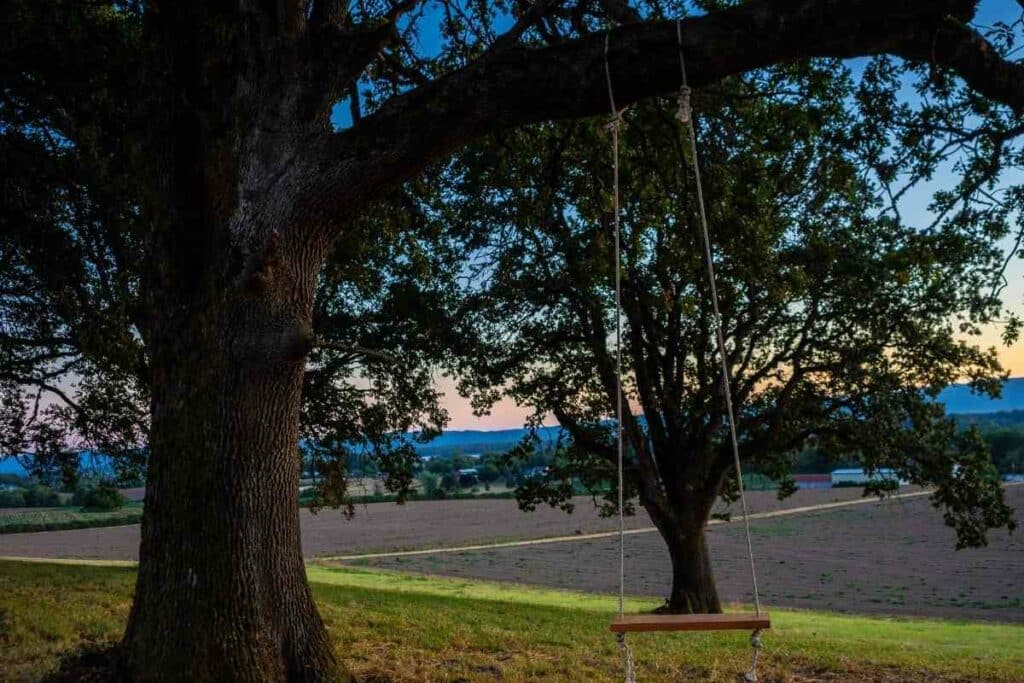Tree swings make for a fun activity for kids and a peaceful place to take in the surroundings for adults. But if you’re not careful, tree swings can also be dangerous.
It’s important to know about the best tree species, height, age, and location, to ensure your tree swing is a safe addition to your yard.
The best trees to hang a swing from should meet these guidelines:
- Strong, healthy, and mature hardwood species
- A branch that’s between 10-15 feet tall
- An area of at least 12 feet of clear space in front and behind the swing
- A soft place to land if the person on the swing falls off
In this article, we’ll explore the reasoning behind these tree swing recommendations, plus learn how you can install a tree swing in your own yard for your entire family to enjoy safely!
What Are the Best Trees for Swings?
To determine an appropriate tree for a tree swing, you should take into account four main categories:
- tree type
- height
- age
- location
1. Type of Tree
The best type of tree for a tree swing is a healthy hardwood tree that’s strong enough to hold the bodyweight of the heaviest person that might swing upon it.
The best tree species for tree swings include:
- Oak trees
- Maple trees
- Sycamore trees
- Hornbeam trees
- Ash trees (as long as the tree is large and healthy)
- Cherry trees (as long as the tree is large and healthy)
- Cedar trees (as long as the tree is large and healthy)
- Beech trees

Each of the species can grow into strong, tall candidates for tree swings and can stand up to the wear and tear of a rope around its branches.
In Addition – Choose a tree that has plenty of branches, including one that is long enough to allow you to safely hang your swing at least six feet away from the trunk.
The tree should also be free from any large bumps, big exposed roots, or highly uneven appendages.
Trees that do not make good tree swing candidates include:
- Pine trees
- Poplar trees
- Spruce trees
- Willow trees
- Silver birch trees
2. Height
Some of the aforementioned trees can grow up to 50 feet tall, but you wouldn’t want to hang your tree swing from that height!
For safety reasons and to maximize the amount of curve in the swing when pushed, you want to hang the swing from a branch that’s somewhere between 10 and 15 feet off the ground.
Anything shorter than 10 feet will stunt the swing’s ability to move back and forth, which isn’t a lot of fun for the person attempting to swing!

Any branch taller than 15 feet may create a curve that’s far to high, creating a dangerous situation if someone were to fall from the swing.
In addition, you want the branch from which you hang your tree swing to be reachable, whether by climbing the tree or using a ladder.
This Way – You can inspect it often to make sure the swing is secure, the branch is still strong, and the tree is not suffering any irreparable damage.
3. Age
The tree should be mature enough to have developed strong, thick branches and a durable and deep root system.
In general, choose a tree that is no younger than 10 years old to ensure that it has had enough time to develop its roots.
This way, you can rest assured that it won’t be ripped from the ground when its yanked by bodyweight on the swing.
Avoid very old trees unless you can be sure of its health. Older trees are more susceptible to rot and disease that may weaken its branches.
Keep In Mind – Older trees may also have a harder time recovering from wounds incurred by the consistent strain of a tree swing.
4. Location
The best tree to hang a swing from will have at least 12 feet of clear space in front of and behind the chosen branch.

The tree should also be away from any obstacles, such as:
- boulders
- walls
- pools
- roads
- furniture
- and other trees or bushes
Finally, choose a tree that has a safe landing zone (or falling zone). You’ll want to avoid a tree that’s on a steep hill, since that could make the fall even farther.
You’ll also want to avoid a tree that’s surrounded in rocks or gravel, and instead choose a landing zone that’s made up of wood chips, grass, or mulch.
How Thick Should a Tree Branch Be for a Swing?
The thickness of the tree branches on your chosen tree will vary based on its species, but no matter the tree type, the branch should be no less than eight inches in diameter.
Be sure to measure the diameter of the branch at the location where you intend to hang the swing, rather than at the location nearest the tree’s trunk.
In general, you should hang the swing no closer than six feet away from the tree trunk.
How to Tell If a Tree Branch Is Strong Enough For a Swing

In addition to the diameter of the tree branch, you should also look out for these indicators that a tree branch is strong enough for a swing:
- The branch doesn’t have any cracks, swelling, or bulges
- The branch doesn’t appear or sound hollow when tapped with a hammer
- The branch is not the only strong-looking branch on the tree
- The branch is not cracking at its joint with the trunk
In order to determine a branch’s condition, it should be inspected from below and above by using a ladder before installing the tree swing.
How to Hang a Swing on a Tree
To hang a swing on a tree, you can use either rope or chain and a wooden seat that won’t decay under the elements, such as one made of cedar or redwood.
Rope should be made of something durable such as polyester or braided nylon that’s at least three quarters of an inch in diameter.
Measure the rope or chain so that the swing sits at least two feet from the ground.

Keep in mind that when that swing seat is weighted, it will cause the branch to flex and the amount of clearance between the seat and the ground to shrink.
To attach the swing to the tree branch, you can either loop the rope or chain around the branch, or drill into the tree and attach the swing with eye bolts.
Always Good Idea – If looping the rope or chain around the branch, place rubber around the rope so that it won’t damage the tree and wear down the rope.
You can purchase a tree swing that’s ready to go, or you can make one yourself!
Final Thoughts
A tree swing can be a fun and wholesome addition to your yard if you understand how to find an appropriate tree from which to hang it.
Avoiding obstacles, finding a strong branch, determining the health, age, and species of your tree, and knowing the warning signs of an unsafe tree are all things to step through to make sure your tree swing provides safe enjoyment for years to come!
